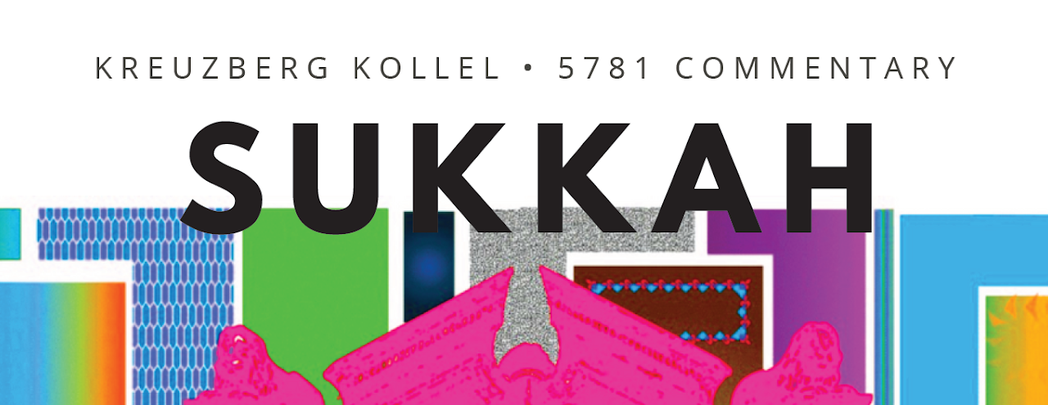Everything Is Illuminated
Talya Feldman
In Sukkah 51a:16 the Mishnah describes a sequence of events for the Simchat Beit Hasho’evah, the Celebration of the Place of the Drawing -- a celebration that the Mishnah claims is one you must see, that you must experience, in order to understand the meaning of celebration at all.
The priests and the Levites descend from the Israelite courtyard to the women’s courtyard on the first day of the Festival, where they introduce what the Gemara later explains as a significant repair. The Mishnah describes how these priests would then proceed to tear strips from their own clothing to use as wicks to light the candelabra in the courtyard.
The light from the candelabra illuminated the courtyards of Jerusalem. The Mishnah states: there was not a courtyard in Jerusalem that was not illuminated from the light of the Place of the Drawing of the Water.
A fantastic image -- to imagine light, as a material, as a liquid, as a form that emanates and flows outwards from a space like the women’s courtyard during the Festival. A light, created from the torn clothing of priests, to signify a significant repair.
In 1994 German artist Mischa Kuball was invited to create a work within the synagogue Stommeln. The synagogue is one of the only synagogues preserved during and after WWII. It avoided being burned by the Nazis because it stands quietly hidden in the small town, behind shops and walls. Unlike its congregants, the synagogue Stommeln survived. Today, the county of Pulheim offers it as a space for contemporary art and installation, a commemorative space for reflection and memory.
In his work, Refraction House, Kuball placed glaring spotlights inside the empty synagogue. He turned them all on, walked out of the building and locked the door. The light from the synagogue Stommeln emanated outwards, almost menacingly, into the city, into every corner and crevice. As if by turning the light outwards onto the city, the emptiness of the synagogue, the loss of its people, became ever more clearer, and more frightening. Is this the repair that the Mishnah is describing through light? Is this the celebration? One that you can only achieve and experience from brokenness? This synagogue, whose congregants were ripped from it in a time of great darkness was illuminated. Illuminating outwards in reference to and in defiance of a light more evil: Nazi searchlights and Albert Speer’s Cathedral of Light.
Independent Curator and Art Critic, Norman L. Kleeblatt, wrote about Kuball’s installation in a 2019 article for the Brooklyn Rail:
Most artists working in this formerly religious, now memorial, space have staged the interior with their signature sculptural fabrications. But Kuball turned things insideout using an approach as deceptively simple as it was shrewd. He lit the inside of the old sanctuary with glaring lights, then locked the doors to the building, thereby restricting viewer access to the interior. The quality of the flagrant light emanating from the windows at night thus prompted memories of the Nazi’s threatening searchlights, simultaneously conjuring Albert Speer’s enormous cathedral of light in Nuremberg that in the 1930s was used as a momentous display of spine-tingling Nazi power. But Kuball’s brilliant strategy of locking the building to preclude visitor access transformed the historical remnant into an inaccessible locus. Consequently, it became the source of light that went on in a place where the metaphorical lights of its congregants were extinguished. Of course, such a strategy also parallels theorist Julia Kristeva’s connective readings between the sacred and the abject. This poetic tactic raises other more complex questions. Why was this a holy site barred to human access? Was it the synagogue’s rare survival under the Nazi regime that made it seem (at least to Kuball) suggestively untouchable?
According to Bava Batra 3b:16-4a:4, Torah is light. The light of the world is the Temple, as it says:
He who extinguished the light of the world by killing the Torah Sages, as it is written: “For the mitzva is a lamp, and the Torah is light” (Proverbs 6:23), should go and occupy himself with the light of the world, the Temple, as it is written with regard to the Temple: “And all the nations shall flow [venaharu] unto it” (Isaiah 2:2), the word venaharu alluding to light [nehora].
We are living in a time without our Temple, the light of the world. We are living in a time when the light of the Beit Hasho’evah, that light illuminating everything, must be lit and pointed outwards from a much darker and more sinister place. A space without celebration, where the light of Torah Sages is extinguished, an entire congregation lost. A broken world in need of a significant repair.
Yet by placing ourselves in the city of Stommeln in 1994, illuminated by the light shining outwards from the inside of an empty synagogue, a remnant of the community that once was -- perhaps then we can understand the ripped clothing of the priests, and the celebration in survival, in light, that can only come from an experience of great terror.
When we don the prayer shawl, an un-ripped cloth, there is a custom to describe it as wrapping ourselves in a Cloak of Light. How powerful is this light, that can wrap us and protect us, that can illuminate the darkness of our cities and our times -- for goodness, for Torah? How great is the light of our Sefirot, which Kabbalah explains as fractions/refractions of light within each of us -- a light that carries us to every crevice and corner, driving out the evil in a broken world? Perhaps the Mishnah is right. There is no other celebration like the Simchat Beit Hasho’evah. For here we stand today -- with ripped clothing, with lost priests and Sages -- in true joy because we are here. And our light is still here, illuminating everything.




